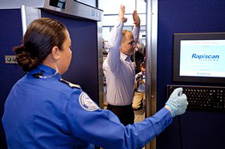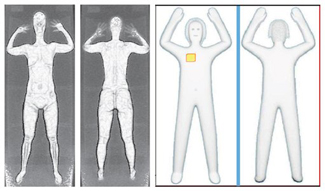TSA removing ‘virtual strip search’ body scanners
Daily News Article — Posted on January 23, 2013

A Transportation Security Administration employee in 2010 demonstrates one of the then-new full-body scanners at Boston’s Logan Airport.
(by Mike M. Ahlers, CNN) Washington — Airport body scanners that produce graphic images of travelers’ bodies will be removed from checkpoints by June, the TSA (Transportation Security Administration) says, ending what critics called “virtual strip searches.”
[The TSA said that it will replace most of the backscatter scanners, which use low doses of radiation (x-rays), with millimeter-wave scanners that filter images using radio waves to depict only potentially hazardous items on a generic human silhouette, rather than an image of the traveler’s body,] raising fewer privacy concerns.The millimeter-wave scanners require flyers to raise hands while a long bar sweeps back and forth, bouncing electromagnetic waves off of them. In backscatters, flyers stand still between two walls that run ionized X-ray beams over their bodies.
[Congress passed a law that banned detailed body images in airport security screenings beginning last June, but the TSA granted a one-year extension to allow the makers of the backscatters, OSI Systems Inc., to change their technology (which they were unable to do)].The TSA move came after Rapiscan, the manufacturer of the 174 so-called “backscatter” machines, acknowledged it could not meet a congressional-ordered deadline to install privacy software on the machines.

Sample images provided by the Transportation Security Administration show what TSA officers see on computer monitors when passengers pass through airport body scanners. At left are two images using backscatter advanced image X-ray technology from scanners introduced in 2010. At right are images from new scanners using millimeter-wave technology that produces a cartoon-like outline.
“It is big news,” said Marc Rotenberg, executive director of the Electronic Privacy Information Center. “It removes the concern that people are being viewed naked by the TSA screener.”
In 2004 and 2005, the TSA at first dismissed privacy concerns, then sought to address them by placing TSA officers viewing the scanner imagery in remote locations, away from the passenger being screened. They also gave passengers the right to an alternative screening — a pat down.
But those solutions failed to appease privacy groups and some members of Congress, who felt both alternatives could be abused [by TSA screeners].
Ultimately, a problem caused by technology was solved by technology. Security companies developed privacy software, called Automated Target Recognition (ATR) software.
But while manufacturers of the less-intrusive “millimeter wave” machines found ways to use ATR software, backscatter machines have not.
This week, the TSA announced it is ending its contract with Rapiscan “due to its inability to deploy non-imaging ATR software.”
“By June 2013 travelers will only see machines which have ATR software that allow for faster throughput. This means faster lanes for the traveler and enhanced security,” the TSA said in a statement. [The TSA said that in addition to moving some of its existing millimeter-wave scanners to help replace the backscatters, the agency has options to purchase 60 more millimeter-wave machines. The agency said the millimeter-wave machines move passengers through the checkpoint faster than backscatters because TSA agents can evaluate a simpler image at the checkpoint rather than in a back room.]
The TSA could allow backscatter machines in the future if the company develops the required software, the TSA said. [Bloomberg news reported that TSA spokesman John Sanders said “We are not pulling the backscatter scanners out because they haven’t been effective, and we are not pulling them out for safety reasons,” Sanders said. “We’re pulling them out because there’s a congressional mandate.”]
Currently, the TSA uses the 174 backscatter machines in 30 airports, and has another 76 units in storage. It uses millimeter wave machines in 170 airports.
The decision to remove the backscatter machine will [alleviate], at least temporarily, travelers’ concerns about the health effects of the machines. Backscatter machines use X-rays [radiation], while millimeter wave machines use radio waves.
The TSA has long maintained both machines are safe, but recently signed an agreement with the National Academy of Sciences to study the scanners. The study will continue even though the machines are being pulled, the TSA said, because they could be reintroduced in the future.
Reprinted here for educational purposes only. May not be reproduced on other websites without permission from CNN. Bracketed text is from a Wall Street Journal article on the scanners.
Background
The Transportation Security Administration, (TSA) was formed immediately following the tragedies of Sept. 11. The agency is a component of the Department of Homeland Security and is responsible for security of the nation’s transportation systems. Read the TSA’s point of view on their “whole-body imaging” machines used for airport security at tsa.gov/approach/tech/body_imaging.shtm.
National Academy of Sciences to Undertake Independent Assessment of Airport Body Scanners: After years of pressure from political leaders, civil liberties and health advocates, including EPIC (the Electronic Privacy Information Center), there will be an independent review of the health risks posed by backscatter x-ray devices. A National Academy of Sciences committee will assess “whether exposures comply with applicable health and safety standards” for passengers and airport employees. The study is limited to radiation and safety testing, and will not examine the privacy implications or effectiveness of the x-ray machines. In 2012, both the House and the Senate introduced legislation calling for an independent assessment of the controversial devices. Europe has also effectively banned the use of backscatter X-ray devices. EPIC has a FOIA lawsuit against DHS concerning body scanner radiation risks. In response to another EPIC lawsuit, the agency will begin a public comment process on the airport screening program in March 2013. (from EPIC website: epic.org/privacy/airtravel/backscatter)
